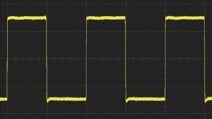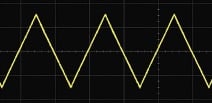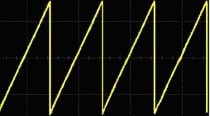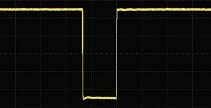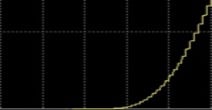このページの日本語版は、現在ご利用いただけません。現在コンテンツの追加および翻訳作業を行なっており、近日公開予定です。
ご投票ありがとうございますA digital oscilloscope is an important tool that is used to understand electronic and electrical circuits. The primary function of any oscilloscope is to measure voltage over time. It produces a graphical display of the waveform, which allows engineers and technicians to visualize the behavior of electrical signals on the scope display.
But what exactly is an oscilloscope waveform?
In this article, we will break down everything you need to know about oscilloscope waveforms. We will look at common and complex waveforms you might see on a digital scope and how to interpret them. This will help you better understand the behavior of electronic circuits, meaning you can diagnose and fix issues more efficiently.
Buy Oscilloscopes at a Great Discount
Select up to 3 instruments to compare
What Is an Oscilloscope Waveform?
A waveform is a graphical representation of an electrical signal on an oscilloscope screen. It shows how the voltage of the signal changes over time. The horizontal axis represents the time interval, while the vertical axis represents the signal's amplitude (maximum voltage). It also shows the wave's shape, frequency, rise time, and distortion. Seeing the waveform represented in this way can tell you a lot about the behavior of electronic circuits.
What Are Waveform Measurements?
Waveform measurements are ways of quantifying different aspects of an oscilloscope waveform. These measurements include the voltage, the frequency, the period, and the duty cycle.
- The voltage of a waveform is its DC offset. The RMS voltage is a measure of the effective voltage of a waveform. You can calculate the voltage by first identifying the scale on the vertical axis of the oscilloscope. For example, if the voltage scale setting is 1V per division, then each square on the grid will represent 1 volt. Then simply count the number of squares the waveform occupies and multiply by the volts per division. For example, if a waveform takes up five squares on a 1V per division scale, its voltage would be 5 volts.
- The frequency of a waveform is the number of times it repeats itself over a given period of time, measured in Hertz (Hz).
- The period of a waveform is the time it takes for the waveform to repeat itself. It is the inverse of the frequency, and the period measurement is in seconds (s).
- The duty cycle of a waveform is the percentage of time that the waveform is above a specific voltage. For example, a 50% duty cycle means that the waveform spends half of its time above that voltage.
Let's now look at various types of waveforms and what they mean.
| Waveform Type | Description |
|---|---|
Sine waves | A sine wave is a smooth, repetitive waveform that alternates between negative and positive peaks. It is the most basic type of waveform and is a common reference for other waveforms. Since sine waves represent periodic events such as sound or light waves, they are the basis for many standard signals used in electronics and telecommunications. |
Square waves | You characterize a square waveform by a sharp transition between its high and low states. This sharp transition causes the wave to resemble a square, hence its name. You typically use square waveforms in digital electronics because they are easily generated and detected using simple logic gates. In addition, square waves can be easily transformed into other waveforms using electronic filters. Digital signals, such as those used in computer buses, often contain square waves. |
Triangle waves | Triangle waves are a waveform that oscillates between two states, spending an equal amount of time in each state. The waveform inverts itself every time it reaches the upper or lower limit of its oscillation, meaning it has a sharp transition in the middle of its cycle. Triangle waves have a distinct shape that differs from other waveforms, such as sine or square waves. The triangular shape comes from the linear rise and fall of the signal between the two states. Triangle waves are commonly used in electronic music, as they can create a wide range of sounds when combined with other waveforms. Communication systems and computer memory devices utilize triangle waves. |
Sawtooth waves | Sawtooth waves are characterized by a rising edge. The waveform drops immediately after itits reaches itsreached it highest amplitude. The name sawtooth comes from the wave's similarity to the teeth of a saw blade. You use sawtooth waves in audio applications, providing a sharper sound than other waveforms. They are also used in synthesis and control systems, as their sharp edges make them well-suited for triggering events. |
Pulse waves | Pulse waves are another waveform characterized by a sharp leading edge and a sharp falling edge. The width of the pulse is typically very short in comparison to the period of the wave. Various applications use pulse waves, including communication systems, computer memory devices, timing circuits, lasers, and electrical motors. |
Stair waves | A stair waveform is an electrical waveform with a step-like shape. When alternating alternate current (AC) passes through a resistive load, it produces a stair waveform. The resulting waveform will have a series of flat plateaus, with each plateau corresponding to a different resistance value. The amount of current flowing through the resistive load determines the height of each plateau. It's common to find stair waveforms in electronic devices such as power supplies and amplifiers. |
Common Waveforms vs. Complex Waveforms
You classify waveforms as either simple or complex.
- Simple waveforms are those that a single trigonometric function can describe, such as a sine wave or a cosine wave.
- Complex waveforms are those that require multiple trigonometric functions to describe them. One example of a complex waveform is a square wave.
While the shape of a square wave may appear simple, an infinite number of sine and cosine waves of different frequencies and amplitudes produce a square wave.
Other examples of complex waveforms include sawtooth waves and triangular waves. Complex waveforms generally tend to have more high-frequency components than simple waveforms.
This aspect can make them challenging to analyze and understand. However, complex waveforms also have the advantage of carrying more information than simple waveforms.
What Is Random Noise?
When measuring waveforms, it is important to be aware of random noise. Random noise is a signal distortion that appears as a random waveform fluctuation.
Random noise comes from various factors, including thermal effects or electrical interference, making it difficult to measure the waveform accurately.
One way to reduce the effect of random noise is to take multiple waveform measurements and average them. This will smooth out the fluctuations caused by the noise and give a more accurate representation of the signal.
What Is Waveform Regeneration?
Waveform regeneration is the process of recreating a degraded digital signal affected by noise or other interference through the use of a digital filter. You can also use an error-correction algorithm to reconstruct the original signal.
You can perform waveform regeneration in real-time to maintain high-quality signals in noisy environments. In others, it may be necessary to store the degraded signal in memory and perform the regeneration offline. Either way, waveform regeneration is an essential tool for maintaining the integrity of digital signals.
Buy a Keysight Premium Used Oscilloscope That Works Like New
Buying a premium used oscilloscope through Keysight is an excellent way to get a top-quality instrument at a fraction of the cost of a new one. Our premium used oscilloscopes can take common and complex waveform measurements quickly and accurately every time.
Keysight's used instruments are rigorously tested and serviced to ensure they meet the same high standards as our new oscilloscopes. Keysight offers a wide range of high-quality, premium refurbished oscilloscopes backed by a 1-year warranty. You can rest easy knowing you're getting a quality product backed by a trusted manufacturer.
So don't wait; see our used equipment page and pick up a premium refurbished oscilloscope with some of the highest standards and specifications in the industry.
Browse Oscilloscopes at a Great Discount
Select up to 3 instruments to compare
Enable Notifications
In order to use this feature, you need to enable notifications.
Manage notification preferences
Did You Know?
Keysight is the only company that can provide calibration. When you buy from our Used Equipment page, you can rest easy knowing that your oscilloscope has been thoroughly tested and calibrated, meaning you can get straight to work and have confidence that you are using a reliable piece of equipment.
No other reseller can provide that guarantee. That's why choosing Keysight for refurbished products is always the smartest choice.
While other resellers’ shipping times vary from 8-21 weeks, we guarantee that our equipment will reach your lab within two weeks*. Keysight Premium Used models are customizable; therefore, the shipping process may be slightly longer. Browse our Keysight Oscilloscope offers and request a quote to speak to a sales agent today.

(* Two weeks shipping time offer available for US customers only. Dependent on item availability and location)
Here Are 4 Ways We Can Help You
- Browse our premium used oscilloscopes
- Call tech support US: +1 800 829-4444
Press #, then 2. Hours: 7 am – 5 pm MT, Mon– Fri - Talk to our sales support team by clicking the icon (bottom right corner) on every offer page
- Talk to your account manager about your specific needs


